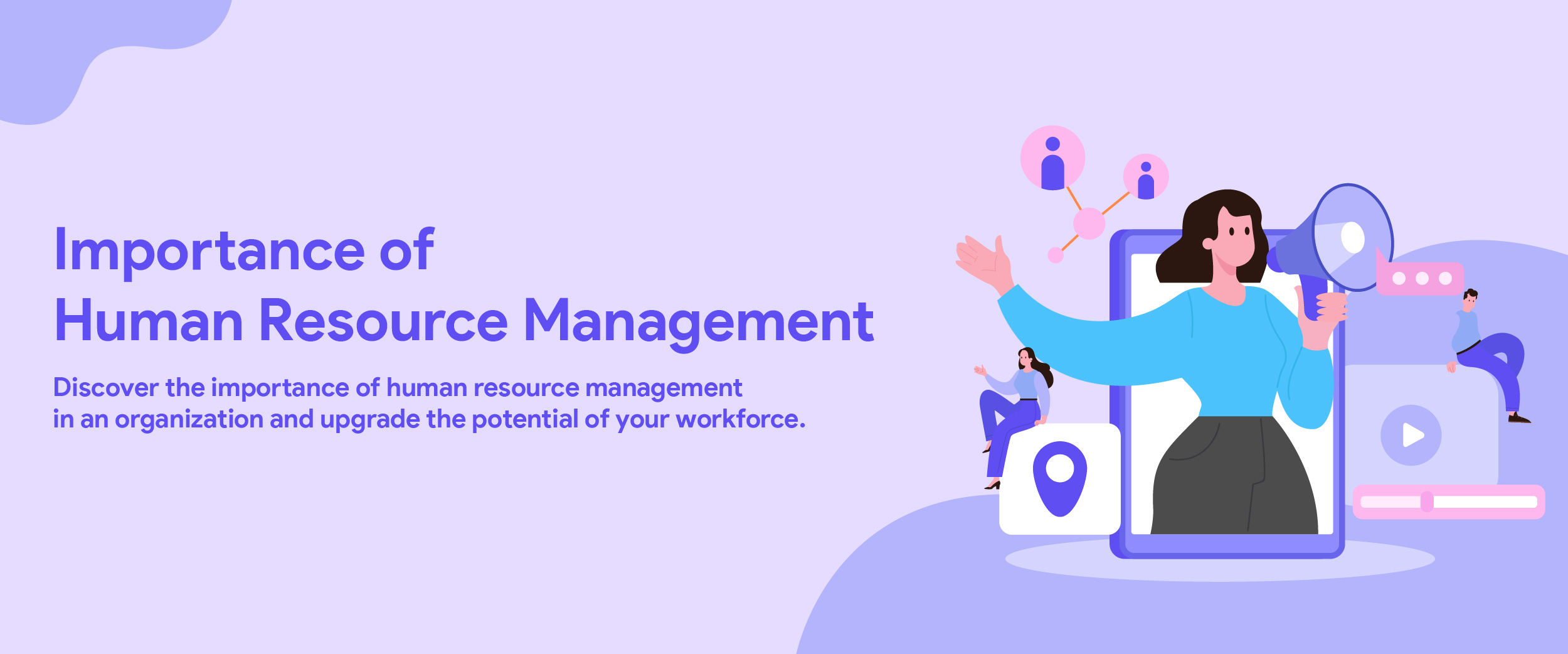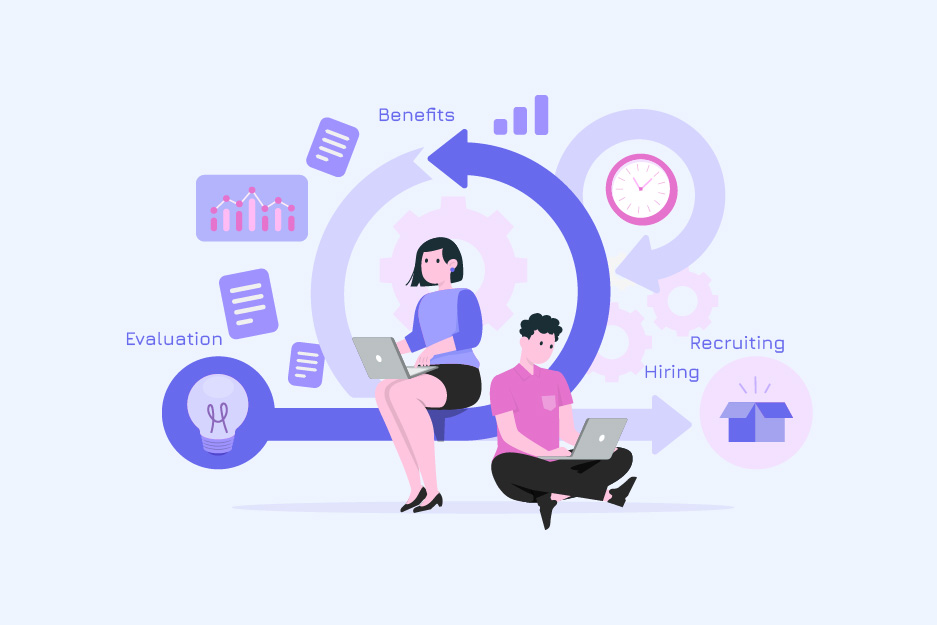Importance of Human Resource Management (HRM)
According to a study, an organization should have an average HR-to-staff ratio of 1:4. This ratio may differ depending on the size of an organization but a balanced ratio ensures enough personnel for efficient management. Human resource management is a practice that involves key components like recruitment, training, development, talent management, labor relations, and compliance. This blog will help you understand the importance of human resource management, its functions, and how it is different from human resource development.
What is Human Resource Management?
HRM is the process of training, recruiting, developing, and managing the talent pool. Effective human resource management fills the gap between the company’s business goal and employees’ success. It also helps support employees in improving their performance and assists every department of an organization in achieving its long-term goals.
Also Read: Objectives of HRM
Importance of Human Resource Management (HRM)
A human resource team supports the growth of a firm or an organization through talent acquisition and employee training. The success story of an organization depends on the employees and its work culture. The objectives of human resource management promote the whole organization’s long-term success and growth. Let us explore the importance of human resource management:
1. Promotes Good Working Relationships and Environment
A healthy work environment is essential for employee well-being and productivity. HR professionals ensure employees feel respected, valued, and safe at their workplace. Here is how HR professionals play an integral role:
- Encourages clear and effective communication within the organization.
- Implements policies that foster mutual respect and collaboration.
- Addresses workplace concerns and conflicts efficiently.
2. Helps in Assisting Budget Control
HRM helps ensure budget control by creating a structured financial compensation plan designed to reflect the value of each job role within an organization. They do so through the following ways:
- Develops fair and competitive salary structures.
- Provides monetary (salaries and bonuses) and non-monetary (healthcare and insurance) benefits.
- Ensures financial resources are allocated wisely by benchmarking pay scales within the industry.
3. Establishes Corporate Reputation
A strong corporate reputation hires talent and enhances stakeholder trust. Human resources management contributes to building and maintaining this image. Here are some ways that help HR boost their company’s reputation in the job market and corporate world:
- Strengthens the company’s brand among employees, customers, and suppliers.
- Implements ethical workplace practices that enhance public perception.
- Improves employee satisfaction and loyalty, leading to lower turnover.


4. Works on the Training and Development of Employees
Training sessions allow employees to develop skills related to their job roles. While, development programs assist them in building life skills like communication, decision-making, leadership qualities, etc. The following points highlight the importance of human resource management in enhancing employee development:
- Conduct job-specific training to enhance technical and soft skills.
- Provide leadership and decision-making programs for career growth.
- Implement mentorship and coaching programs to support long-term development.
5. Closes the Gap Between Human Resource Supply and Demand
HRM is about managing and directing employees toward a successful operation within an organization. It includes various activities, such as employee recruitment and selection, training and professional development, overseeing performance management systems, and developing workplace policies. HRM ensures organizations have the right talent to meet their evolving needs through the following ways:
- Oversee recruitment, selection, and workforce planning.
- Develop training programs to align employee skills with business goals.
- Ensure compliance with labor laws and industry regulations.
6. Profit and Productivity Management
HRM helps maintain and manage a qualified workforce to ensure organizational profit. It also involves creating suitable opportunities for the existing employees to develop their skills. By retaining key organizational personnel, HRM facilitates sustained growth, leading to success. Here’s how HRM optimizes workforce performance to enhance productivity and profitability:
- Create professional growth opportunities to retain skilled employees.
- Reduce turnover, lowering hiring and training costs.
- Encourage innovation and collaboration for better business outcomes.
7. Helps with Employee Motivation and Retention
Motivated employees contribute significantly to an organization’s success. HRM implements strategies to keep them engaged and committed. The importance of HRM helping with employee retention is as follows:
- Offer competitive compensation and benefits packages.
- Provide career growth opportunities and professional development programs.
- Foster a supportive work environment with recognition and reward systems.
8. Aids in Providing Quality Work Life
HRM makes efforts to help reduce employee burnout and stress, leading to better job satisfaction. A friendly workplace guarantees employees feel appreciated and motivated, which impacts their general performance and retention in the company. HRM uses the following methods to ensure work-life balance:
- Implement flexible work arrangements and wellness programs.
- Reduce workplace stress through employee support initiatives.
- Encourage a sense of belonging and job autonomy.
To learn more about the importance of HRM, you can opt for an in-depth HR course.
9. Promotes Organizational Values and Culture
HRM shapes and sustains an organization’s values and culture. It aligns recruitment, training, and development initiatives with core company values. This fosters a positive, cohesive work environment that enhances employee engagement and organizational success. Some of the ways through which the importance of HRM promotes organizational values in the workplace are:
- Reinforces company values through recruitment and training initiatives.
- Encourages employees to uphold ethical practices and teamwork.
- Enhances job satisfaction by creating a cohesive work environment.
10. Guarantees Risk Mitigation and Legal Compliance
HRM is essential in managing labor laws and regulatory requirements to protect businesses from legal risks. By staying updated on legal obligations and implementing compliant policies, HR helps organizations avoid legal disputes and financial penalties. This proactive approach ensures a fair, ethical, and legally sound workplace. Here is how HRM guarantees risk mitigation and legal compliance in the workplace:
- Implements workplace policies that align with industry regulations.
- Conducts training programs to educate employees on compliance matters.
- Minimizes financial penalties by proactively managing legal obligations.
11. Promotes Strategic Workforce Planning
HRM is key in strategic workforce planning and ensuring the right talent is available with the necessary skills at the right time. It helps align human resources with business goals while proactively anticipating future staffing needs. Through effective planning and talent management, HRM enables organizations to stay competitive and adaptable in a dynamic business environment. Here’s how HRM promotes strategic workforce planning are:
- Anticipates future staffing needs and develops recruitment strategies.
- Ensures skill development aligns with evolving industry demands.
- Helps businesses remain adaptable and competitive in a dynamic environment.
12. Improves Employee Contentment and Engagement
HRM increases employee engagement and satisfaction by implementing policies that support work-life balance, acknowledge successes, and offer career development. Engaged employees are more productive, committed, and less likely to leave the organization. Here’s how HRM ensures employees contribute positively to workplace morale and productivity:
- Implements initiatives that promote work-life balance.
- Recognizes employee contributions through incentives and rewards.
- Creates opportunities for professional growth and skill enhancement.
13. Promotes Development and Organizational Change
HRM handles organizational change during mergers, acquisitions, or restructuring. It ensures a smooth transition by facilitating clear communication, providing necessary training, and supporting employees in adapting to new challenges. Here’s how HRM helps organizations navigate change effectively:
- Supports employees during transitions like mergers or restructurings.
- Facilitates training programs to ease adaptation to new processes.
- Encourages open communication to minimize resistance to change.
14. Supports Diversity and Inclusion Initiatives
HRM is at the forefront of promoting diversity and inclusion within the workplace. It helps companies gain from different viewpoints and experiences by implementing rules supporting different hiring practices and an inclusive culture. This boosts the organization to innovate, adapt to new practices, and have better performance. Here’s what HRM do to promote diversity and inclusion:
- Implements unbiased recruitment and promotion policies.
- Encourages a workplace culture that values different perspectives.
- Enhances business performance through varied ideas and experiences.
15. Management of Benefits and Compensation
HRM designs and administers competitive compensation and benefits packages to attract and retain top talent. Regular assessment and modification of these packages guarantee the company stays competitive in the job market and the employees feel valued and fairly paid. Here’s how the importance of HRM is reflected in the management of employee benefits and compensation:
- Designs salary structures that attract and retain talent.
- Regularly reviews and updates benefits based on industry standards.
- Enhances employee satisfaction by ensuring equitable pay.
16. Improves Retention and Talent Acquisition
Attracting top personnel and guaranteeing the company retains qualified staff depends on HRM practices. HRM helps lower employee turnover and build a robust team of qualified personnel using effective recruitment procedures, competitive perks, and providing a good work environment. Effective HRM practices help organizations build a skilled and stable workforce through the following means:
- Use strategic hiring processes to attract top professionals.
- Provide employee development opportunities to enhance retention.
- Create a positive work environment that encourages long-term commitment.
Pro Tip: To learn more about the importance of HRM, enroll in this industry-oriented HRM course with placement and explore top career options like HR Recruiter, HR Associate, HR Analyst, and more.
Human Resource Management vs. Human Resource Development
The HR department can be divided into two distinct areas: human resource development and human resource management. Both HRM and HRD are important for an organization to function efficiently. The following are the key differences between HRM and HRD.
| Human Resource Management (HRM) | Human Resource Development (HRD) |
| It is a management function. | It is a part of HRM. |
| It helps enhance the productivity of the employees. | It helps in improving the skills, aptitude, and ability of employees. |
| Its functions are reactive, meaning they respond to and address issues and challenges as they arise. | It is proactive, meaning it takes a forward-thinking and preventive approach. |
| It focuses on people management and principles. | It focuses on the development and enhancement areas of the entire firm. |
| It secures legal allowance. | It contributes to long-term growth through development. |
HRM Functions
The functions of human resource management are important for the growth and development of the organization and its employees. The functions broadly entail hiring, training, conflict resolution, etc. This section highlights the importance of human resource management in terms of the crucial functions it carries out:
1. Planning
Planning is a crucial function for setting goals and developing effective strategies. It helps forecast workforce demands, streamline selection, and analyze staffing needs. Additionally, it ensures the efficient use of human and non-human resources while minimizing risks, uncertainties, and confusion.
2. Directing
It is a part of managerial functions, which helps in communication, supervision, leadership, and motivation. It is also known as the relational features of the management and spark of the project or business.
3. Controlling
It is a process of fixing performance and checking progress towards the target goal. Controlling can be done by building standard performance, comparing the current performance with the targets, and finding the variance.
4. Organizing
It is a combination of identification, classification, and coordination. When organizing a business or a firm, you should identify the tasks and activities required to achieve the goals. This function in HRM helps classify these activities based on their functions and departments to the appropriate individuals or teams. It also coordinates with their efforts to ensure efficient and effective plan implementation.
5. Recruitment
Recruitment and onboarding is one of the essential functions of HR management. It selects the right talent according to the organization’s requirements.
6. Performance Management
It is a function where HR provides the employees with a working environment focused on promoting productivity and efficiency. Performance management creates communication between the employees and the managers and streamlines the employee performance and efforts essential to achieve the organizational goals.
7. Rewards and Recognition
HRM utilizes reward and recognition programs to ensure employees’ commitment to producing high-quality work. When employees are rewarded and recognized for their work, they are motivated to perform better and yield higher results.
8. Compensation and Benefits
Another HRM function that helps attract and retain employees is providing compensation and benefits. These include monetary compensation, food, healthcare benefits, gym memberships, bonuses, casual dress codes, flexible work schedules, etc. Employees feel motivated to work when compensated well at work. Further, job seekers are more likely to apply to organizations that offer benefits over and above the basic salary.
9. Health and Safety
HRM involves implementing occupational health and safety programs to foster safe workplaces. This includes identifying risky situations, creating mitigation plans, assessing safety programs, legal compliance, and promoting a safety culture.
10. Administrative Function & Compliance
This includes handling responsibilities like training, transfers, promotions, leave records, contract preparation, etc. Further, HRM ensures adherence to industry standards and compliance with legal requirements and guarantees employees receive their workplace entitlements like compensation and benefits.
Want to work as a dynamic HR professional? Enroll in this industry-oriented HRM placement guarantee course and explore top career options like HR Recruiter, HR Associate, HR Analyst, and more.
Human Resource Management vs Human Resource Development
The HR department can be divided into two distinct areas: human resource development and human resource management. Both HRM and HRD are important for an organization to function efficiently. The following are the key differences between HRM and HRD.
| Human Resource Management (HRM) | Human Resource Development (HRD) |
|---|---|
| It is a management function. | It is a part of HRM. |
| It helps enhance the productivity of the employees. | It helps in improving the skills, aptitude, and ability of employees. |
| Its functions are reactive, meaning they respond to and address issues and challenges as they arise. | It is proactive, meaning it takes a forward-thinking and preventive approach. |
| It focuses on people management and principles. | It focuses on the development and enhancement areas of the entire firm. |
| It secures legal allowance. | It contributes to long-term growth through development. |


HRM Functions
HRM functions work in numerous industries and sectors, helping with problems related to motivation, hiring, training, and development. The primary functions of HRM are given below.
Planning
For meeting the goal and developing strategies, planning is an important function. It helps forecast demands, ease the selection process, and analyze the workforce. It is important in implementing human and non-human resources and helps in evading risks, uncertainties, and confusion.
Directing
It is a part of managerial functions, which helps in communication, supervision, leadership, and motivation. It is also known as the relational features of the management and spark of the project or business.
Controlling
It is a process of fixing performance and checking progress towards the target goal. Controlling can be done by building standard performance, comparing the current performance with the targets, and finding the variance.
Organizing
It is a combination of identification, classification, and coordination. For organizing a business, or a firm, you need to identify the tasks and activities required to achieve the goals. This function in HRM helps classify these activities based on their functions and departments to the appropriate individuals or teams. It also coordinates with their efforts to ensure efficient and effective implementation of the plan.
Recruitment
One of the essential functions of HR management is the recruitment and onboarding of suitable candidates. It works towards attracting and selecting the right talent according to the organization’s requirements.
Performance Management
It is a function where HR provides the employees with a working environment focused on promoting productivity and efficiency. Performance management creates communication between the employees and the managers and streamlines the employee performance and efforts essential to achieve the organizational goals.
Rewards and Recognition
HRM utilizes reward and recognition programs to ensure the commitment of the employees toward producing high-quality work. When employees are rewarded and recognized for their work, they are motivated to perform better and yield higher results for the organization.
Compensation and Benefits
Another HRM function that helps in attracting and retaining employees in an organization is providing compensation and benefits. These include monetary compensation, food, healthcare benefits, gym memberships, bonuses, casual dress codes, flexible work schedules, etc. Employees feel motivated to work when compensated well at work. Further, job seekers are more likely to apply to organizations that offer benefits over and above the basic salary.
Health and Safety
HRM involves implementing occupational health and safety programs to foster safe workplaces. This includes identifying risky situations, creating mitigation plans, assessing the working of the safety programs, legal compliance, and promoting a safety culture.
Administrative Function & Compliance
This includes handling responsibilities like training, transfers, promotions, leave records, preparation of contracts, etc. Further, HRM ensures adherence to industry standards and compliance with legal requirements and guarantees that employees receive their contractual workplace entitlements like compensation and benefits.
Conclusion
Human resource management is crucial for every organization. It is vital to understand the importance of HRM as it helps complete targets and improve employee performance by assisting and enhancing their work. The importance of the human resource department has been advancing worldwide and has become an indispensable part of every successful organization.
FAQs
The most important part of human resource management (HRM) is talent management, which includes recruiting, training, and retaining employees.
The scope of human resource management (HRM) covers all aspects of managing an organization’s workforce. It includes:
a) Recruitment and selection of the right talent.
b) Training and development to enhance employee skills and career growth.
c) Designing salary structures, incentives, and perks.
d) Maintaining employee relations to ensure a positive work culture.
e) Workforce planning and managing succession needs.
f) Compliance with labor laws to ensure ethical workplace practices.
g) Performance management to evaluate and improve employee performance.
Strategic human resource management is important because it helps align an organization’s goals and objectives with those of its employees.
Yes, training and development is a key component of human resource management.







